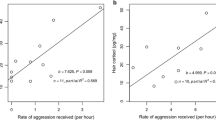Summary
-
1.
It was tested whether gonadal hormones regulate aggression directed toward juvenile conspecifics by adult prairie deer mice (Peromyscus maniculatus). Aggression was measured by counting the number of wounds on the underside of the skin of juveniles that had been paired overnight with unfamiliar adults. One experiment also included direct observations of fighting behavior.
-
2.
Adult deer mice readily attacked juveniles. Under the testing conditions employed there was no difference in aggression as a function of sex of the adult, rearing condition (one vs five animals per cage) of the adult, or sex of the juvenile (Table 1).
-
3.
Castrated adult males wounded juveniles less severely than did intact males (Table 2, P<0.02). The extent to which adult females wounded juveniles was not influenced by ovariectomy. Gonadectomy reduced body growth in both males (P<0.001) and females (P<0.03).
-
4.
Pellets of testosterone propionate were implanted beneath the skin of castrated males. As measured by both wounding scores and the frequency of observed attacks, the aggression of these castrates toward juvenles was increased by hormone treatment (Table 3, P<0.05) to a level comparable with that of intact males. Thus, it is concluded that androgenic hormone secreted by the testes regulates aggression directed toward juveniles by adult male deer mice.
Similar content being viewed by others
References
Ayer, M.L.: Female aggression in asymptotic laboratory populations of prairie deermice. M.S. thesis, North Carolina State University, Raleigh, NC (1978)
Barfield, R.J., Busch, D.E., Wallen, K.: Gonadal influence on agonistic behavior in the male domestic rat. Horm. Behav. 3, 247–259 (1972)
Barr, A.J., Goodnight, J.H., Sall, J.P. Helwig, J.T.: A user's guide to SAS 76, Raleigh, North Carolina: SAS Institute 1976
Bediz, G.M., Whitsett, J.M.: Social inhibition of sexual maturation in male prairie deer mice. J. Comp. Physiol. Psychol. 93, 493–500 (1979)
Blar, W.F.: Population dynamics of rodents and other small mammals. Adv. Genet. 5, 1–41 (1953)
Brain, P.F.: Hormones and aggression, Vol. 1. Montreal: Eden 1977
Bronson, F.H., Desjardins, C.: Steroid hormones and aggressive behavior in mammals. In: The physiology of aggression and defeat. Eleftheriou, B.E., Scott, J.P., (eds.) pp. 43–63. New York: Plenum 1971
Chitty, D., Phipps, E.: Seasonal changes in survival in mixed popuations of two species of vole. J. Anim. Ecol. 35, 313–331 (1966)
Christian, J.J.: Population density and reproductive efficiency. Biol. Reprod. 4, 248–294 (1971a)
Christian, J.J.: Fighting, maturity, and population density in Microtus pennsylvanicus. J. Mammal. 52, 556–567 (1971b)
Christian, J.J., Davis, D.E.: Endocrines, behavior and population. Science 146, 1550–1560 (1964)
Fairbairn, D.J.: The spring decline in deer mice: Death or dispersal? Can. J. Zool 55, 84–92 (1977)
Fordham, R.A.: Fleld populations of deermice with supplemental food. Ecology 52, 138–146 (1971)
Grant, P.R.: Dispersal in relation to carrying capacity. Proc. Natl. Acad. Sci. USA 75, 2854–2858 (1978)
Gray, L.E., Jr., Whitsett, J.M., Ziesenis, J.S.: Hormonal regulation of aggression toward juveniles in female house mice. Horm. Behav. 11, 310–322 (1978)
Healey, M.C.: Aggression and self-regulation of population size in deer mice. Ecology 48, 377–392 (1967)
Krebs, C.J., Gaines, M.S., Keller, B.L., Myers, J.H., Tamarin, R.H.: Population cycles in small rodents. Science 179, 35–41 (1973)
Lawton, A.D.: Urine from adult males inhibits the sexual maturation of male prairie deermice (Peromyscus maniculatus bairdii). M.S. thesis, North Carolina State University, Raleigh, NC (1978)
Lidicker, W.Z., Jr.: The role of dispersal in the demography of small mammals. In: Small mammals: their productivity and population dynamics. Golley, F.B., Petrusewicz, K., Ryszkowski, L. (eds), pp. 103–128. Cambridge: Cambridge University 1975
Lombardi, J.R., Vandenbergh, J.G.: Pheromonally induced sexual maturation in females: Regulation by the social environment of the male. Science 196, 545–546 (1977)
Lorenz K.: On aggression. New York: Harcourt, Brace & World 1966
McCabe, T.T., Blanchard, B.D.: Three species of Peromyscus. Santa Barbara, California, Rood Associates 1950
Mugford, R.A., Nowell, N.W.: Pheromones and their effect on aggression in mice. Nature 226, 967–968 (1970)
Rowley, M.H., Christian, J.J.: Intraspecific aggression of Peromyscus leucopus. Behav. Biol. 17, 249–253 (1976)
Sadleir, R.M.F.S.: The relationship between agonistic behavior and population changes in the deermouse, Peromyscus maniculatus (Wagner). J. Anim. Ecol. 34, 331–352 (1965)
Savidge, L.R.: Social factors in dispersal of deer mice (Peromyscus maniculatus) from their natal site. Am. Midl. Nat. 91, 395–405 (1974)
Service, J.: A user's guide to the statistical analysis system. Raleigh, North Carolina: Sparks 1972
Stickel, L.F.: Home range and travels. In: Biology of Peromyscus (Rodentia). King, J.A. (ed.), pp. 373–411. Am. Soc. Mammal Spec. Publ. No. 2 (1968)
Terman, C.R.: Population fluctuations of Peromyscus maniculatus and other small mammals as revealed by the North American census of small mammals. Am. Midl. Nat. 76, 419–426 (1966)
Thompson, D.C.: The social system of the grey squirrel. Behaviour 64, 305–328 (1978)
Trivers, R.L.: Parent-offspring conflict. Am. Zool. 14, 249–264 (1974)
Whitsett, J.M.: The development of aggressive and marking behavior in intact and castrated male hamsters. Horm. Behav. 6, 47–57 (1975)
Yahr, P., Coquelin, A., Martin, A., Scouten, C.W.: Effects of castration on aggression between male Mongolian gerbils. Behav. Biol. 19, 189–205 (1977)
Ziesenis, J.S., Davis, D.E., Smith, D.E.: Diel variations in the aggressive behaviour of the mouse, Mus musculus. Anim. Behav. 23, 941–948 (1975)
Author information
Authors and Affiliations
Additional information
Address for reprints
Rights and permissions
About this article
Cite this article
Mal Whitsett, J., Gray, L.E. & Bediz, G.M. Gonadal hormones and aggression toward juvenile conspecifics in prairie deer mice. Behav Ecol Sociobiol 6, 165–168 (1979). https://doi.org/10.1007/BF00292564
Received:
Accepted:
Issue Date:
DOI: https://doi.org/10.1007/BF00292564




